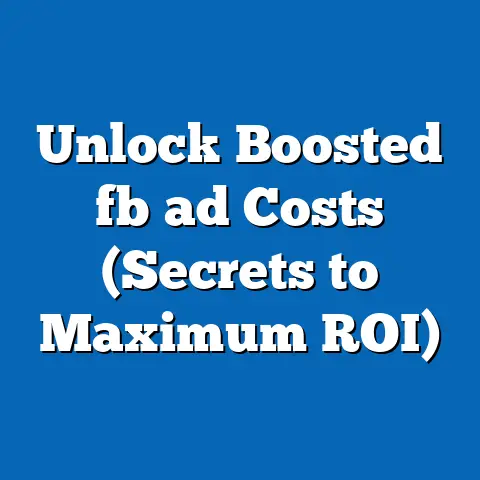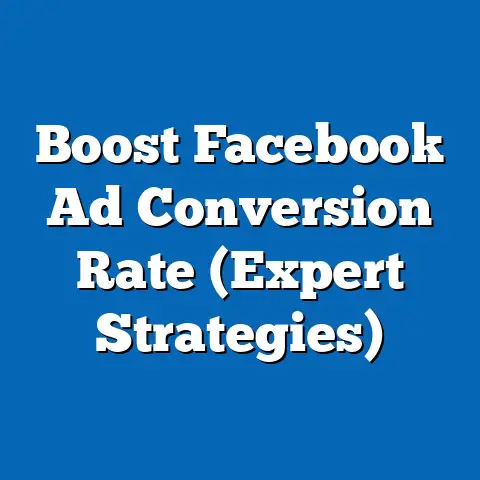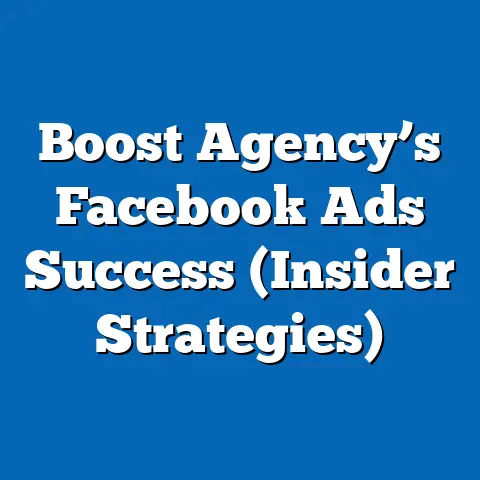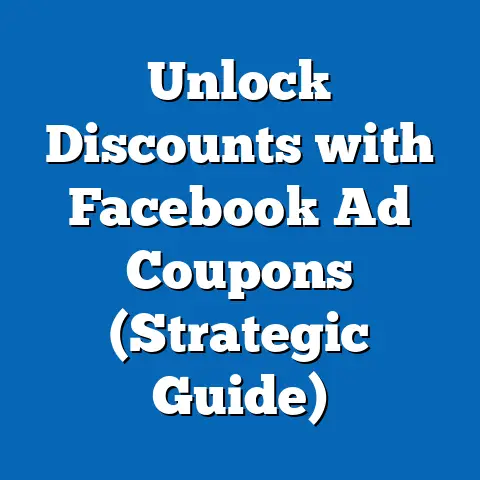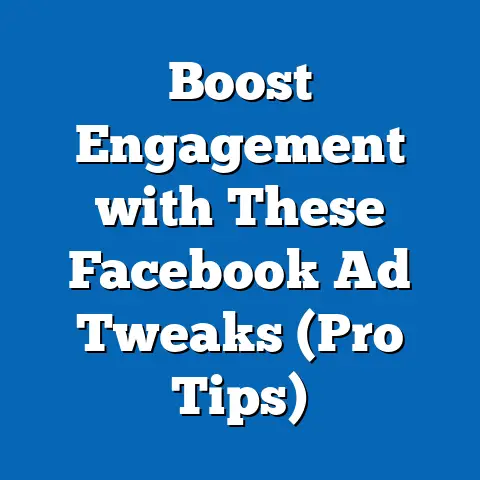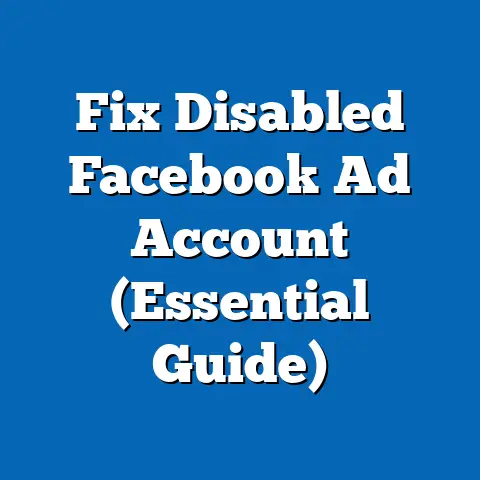Unlock Dynamic Ads on Facebook (Game-Changing Tactics)
I remember when I first started in digital marketing, Facebook ads felt like throwing spaghetti at the wall and hoping something stuck. We’d spend hours crafting the perfect ad copy, selecting what we thought was the ideal audience, and then… crickets. Or, worse, a trickle of clicks that didn’t translate into sales. It was frustrating, to say the least.
Then came dynamic ads. I’ll never forget the first time I saw a dynamic ad in action. It was for an online clothing store, and it showcased the exact pair of shoes I had been eyeing on their website just hours before. It felt like magic, and it definitely piqued my interest. That’s when I realized the power of personalization and how it could revolutionize the way we advertise.
Fast forward to today, and dynamic ads are no longer a novelty; they’re a necessity. They’ve transformed the advertising landscape by allowing businesses to deliver highly relevant and personalized messages to potential customers, leading to increased engagement, higher conversion rates, and a significantly better return on investment.
Think about it: you’re scrolling through Facebook, and instead of seeing generic ads, you see products you’ve actually browsed, items that complement your past purchases, or special offers tailored just for you. It’s a much more compelling experience, right?
Let’s consider a hypothetical example: “Gadget Galaxy,” a struggling online electronics retailer. They were spending a fortune on generic Facebook ads, targeting broad demographics with limited success. Their website traffic was decent, but conversion rates were dismal. Then, they implemented a dynamic ad strategy. They uploaded their product catalog, installed the Facebook Pixel, and started retargeting website visitors with ads showcasing the specific products they had viewed. The results were astounding. Within weeks, Gadget Galaxy saw a 150% increase in sales, a significant reduction in their cost per acquisition, and a dramatic improvement in customer engagement.
This kind of transformation isn’t just a lucky break; it’s the result of a well-planned and executed dynamic ad strategy. In this article, I’m going to break down everything you need to know to unlock the game-changing potential of dynamic ads on Facebook, from understanding the fundamentals to implementing advanced tactics that will maximize your ROI. I’ll share my personal experiences, insights, and actionable tips that you can use to turn your advertising strategy around and achieve similar success.
Understanding Dynamic Ads
Definition and Overview
So, what exactly are dynamic ads? Simply put, they are Facebook ads that automatically display relevant products or services to people who have expressed interest in them on your website, in your app, or elsewhere on the internet. Unlike standard ads, which require you to manually create and target each ad, dynamic ads use your product catalog and the Facebook Pixel to dynamically generate ads based on user behavior and preferences.
Think of it as a personalized shopping experience delivered directly to your target audience. Instead of showing everyone the same generic ad, you’re showing them the specific products or services they’re most likely to be interested in, based on their past interactions with your business.
The beauty of dynamic ads lies in their automation. Once you’ve set up your product catalog and the Facebook Pixel, the system takes over, automatically creating and optimizing ads based on user data. This not only saves you time and effort but also ensures that your ads are always relevant and engaging.
The Importance of Personalization
In today’s digital landscape, personalization is no longer a luxury; it’s an expectation. Consumers are bombarded with ads every day, and they’re increasingly likely to tune out anything that doesn’t feel relevant to them. That’s where personalization comes in.
Personalized ads are more likely to capture attention, generate interest, and drive conversions. According to a study by Epsilon, 80% of consumers are more likely to make a purchase when brands offer personalized experiences. Another study by McKinsey found that personalized recommendations drive 26% of retail sales.
These statistics speak volumes. Personalization is not just a buzzword; it’s a proven strategy for improving ad performance and driving business growth. By delivering highly relevant and personalized messages to your target audience, you can cut through the noise, capture their attention, and increase your chances of making a sale.
I’ve seen this firsthand in my own campaigns. When I switched from generic ads to dynamic ads, I saw a dramatic improvement in my click-through rates, conversion rates, and overall ROI. It’s like I was finally speaking directly to my audience, showing them exactly what they wanted to see.
Key Features of Dynamic Ads
Dynamic ads come packed with features that make them incredibly powerful and versatile. Here are some of the key features you should be aware of:
- Automated Product Recommendations: This is perhaps the most fundamental feature of dynamic ads. The system automatically recommends products or services to users based on their past browsing behavior, purchase history, and other data points.
- Retargeting Capabilities: Dynamic ads excel at retargeting users who have visited your website or app but haven’t yet made a purchase. By showing them the specific products they viewed, you can remind them of their interest and encourage them to complete the transaction.
- Audience Segmentation: Dynamic ads allow you to segment your audience based on a variety of factors, such as demographics, interests, and behaviors. This enables you to deliver even more targeted and personalized messages.
- Dynamic Creative Optimization: This feature allows you to automatically test different ad formats, headlines, and calls-to-action to see what resonates best with your audience. The system then optimizes your ads based on these results, ensuring that you’re always showing the most effective version of your ad.
- Cross-Device Targeting: Dynamic ads can target users across multiple devices, ensuring that your message is consistent and relevant regardless of how they’re accessing Facebook.
These features work together to create a seamless and personalized user experience. By leveraging the power of automation and data-driven insights, you can deliver highly relevant and engaging ads that drive results.
Takeaway: Dynamic ads are a game-changer because they automate personalization, showing the right products to the right people at the right time. Understanding their features is the first step to unlocking their potential.
Setting Up Dynamic Ads on Facebook
Now that you understand the fundamentals of dynamic ads, let’s dive into the practical steps of setting them up on Facebook. This process involves creating a product catalog, integrating the Facebook Pixel, and defining your target audiences.
Creating a Product Catalog
Your product catalog is the foundation of your dynamic ad strategy. It’s a file that contains information about all the products or services you want to advertise, including their names, descriptions, images, prices, and availability.
Here’s a step-by-step guide on how to create a product catalog in Facebook Business Manager:
- Go to Facebook Business Manager: Log in to your Business Manager account or create one if you don’t already have one.
- Navigate to Catalogs: In the Business Manager menu, find “Catalogs” under the “Assets” section.
- Create a New Catalog: Click on the “Create Catalog” button.
- Choose Your Catalog Type: Select the appropriate catalog type based on what you’re selling (eCommerce, Travel, Real Estate, etc.).
- Name Your Catalog: Give your catalog a descriptive name that reflects its contents.
- Assign Permissions: Grant access to the relevant ad accounts and business pages that will be using the catalog.
-
Upload Your Product Data: You have several options for uploading your product data:
- Manual Upload: You can manually add products one by one through the Business Manager interface. This is a good option if you have a small number of products.
- Data Feed: You can upload a CSV, TSV, or XML file containing your product data. This is the most common and efficient method for larger catalogs.
- Pixel Integration: You can connect your website to the Facebook Pixel and automatically populate your catalog with product data based on user interactions.
- Partner Platforms: You can integrate with e-commerce platforms like Shopify, WooCommerce, or Magento to automatically sync your product data.
- Schedule Updates: If you’re using a data feed, schedule regular updates to ensure that your catalog is always up-to-date with the latest product information, prices, and availability.
Upload Your Product Data: You have several options for uploading your product data:
- Manual Upload: You can manually add products one by one through the Business Manager interface. This is a good option if you have a small number of products.
- Data Feed: You can upload a CSV, TSV, or XML file containing your product data. This is the most common and efficient method for larger catalogs.
- Pixel Integration: You can connect your website to the Facebook Pixel and automatically populate your catalog with product data based on user interactions.
- Partner Platforms: You can integrate with e-commerce platforms like Shopify, WooCommerce, or Magento to automatically sync your product data.
- Schedule Updates: If you’re using a data feed, schedule regular updates to ensure that your catalog is always up-to-date with the latest product information, prices, and availability.
Tips for Optimizing Product Images and Descriptions:
Here’s a detailed walkthrough of how to install and configure the Pixel on your website:
- Create a Pixel: In Facebook Business Manager, navigate to “Pixels” under the “Events Manager” section. Click on the “Create Pixel” button.
- Name Your Pixel: Give your Pixel a descriptive name.
-
Install the Pixel Code: You have several options for installing the Pixel code:
- Manually Add Pixel Code to Website: You can copy and paste the Pixel code into the header section of your website. This requires some technical knowledge.
- Use an Integration or Tag Manager: You can use a platform like Google Tag Manager or a plugin for your e-commerce platform to install the Pixel code without directly editing your website’s code.
- Email Instructions to a Developer: You can email the Pixel code and instructions to your web developer.
- Verify Pixel Installation: Once you’ve installed the Pixel code, use the Facebook Pixel Helper Chrome extension to verify that it’s firing correctly.
- Configure Standard Events: Standard events are predefined actions that you can track on your website, such as “ViewContent,” “AddToCart,” “Purchase,” etc. Configure these events to track user behavior and optimize your dynamic ad campaigns.
- Set Up Custom Conversions: Custom conversions allow you to track specific actions on your website that aren’t covered by standard events. For example, you can create a custom conversion to track newsletter sign-ups or contact form submissions.
Install the Pixel Code: You have several options for installing the Pixel code:
- Manually Add Pixel Code to Website: You can copy and paste the Pixel code into the header section of your website. This requires some technical knowledge.
- Use an Integration or Tag Manager: You can use a platform like Google Tag Manager or a plugin for your e-commerce platform to install the Pixel code without directly editing your website’s code.
- Email Instructions to a Developer: You can email the Pixel code and instructions to your web developer.
- Verify Pixel Installation: Once you’ve installed the Pixel code, use the Facebook Pixel Helper Chrome extension to verify that it’s firing correctly.
- Configure Standard Events: Standard events are predefined actions that you can track on your website, such as “ViewContent,” “AddToCart,” “Purchase,” etc. Configure these events to track user behavior and optimize your dynamic ad campaigns.
- Set Up Custom Conversions: Custom conversions allow you to track specific actions on your website that aren’t covered by standard events. For example, you can create a custom conversion to track newsletter sign-ups or contact form submissions.
Why is the Facebook Pixel so important?
The Facebook Pixel is your eyes and ears on your website. It collects valuable data about user behavior, such as which pages they visit, which products they view, and which actions they take. This data is then used to optimize your dynamic ad campaigns, target the right audiences, and measure your ROI. Without the Pixel, your dynamic ads would be flying blind.
Defining Target Audiences
Once you’ve set up your product catalog and the Facebook Pixel, it’s time to define your target audiences. Dynamic ads offer a variety of audience targeting options, including:
- Website Custom Audiences: These audiences are created based on user behavior on your website. You can target users who have visited specific pages, viewed certain products, or added items to their cart.
- App Custom Audiences: Similar to website custom audiences, these audiences are created based on user behavior in your app.
- Lookalike Audiences: Lookalike audiences are created by identifying users who share similar characteristics with your existing customers. This is a great way to expand your reach and find new potential customers.
- Saved Audiences: These audiences are created based on demographics, interests, and behaviors. You can use saved audiences to target users who are likely to be interested in your products or services.
Building Custom and Lookalike Audiences:
- Start with Your Best Customers: Identify your most valuable customers and use them as the seed audience for your lookalike audiences.
- Segment Your Audiences: Segment your audiences based on their behavior and interests. This will allow you to deliver more targeted and personalized messages.
- Test Different Audience Sizes: Experiment with different audience sizes to find the sweet spot between reach and relevance.
- Refresh Your Audiences Regularly: Regularly update your custom and lookalike audiences to ensure that they’re still relevant and accurate.
Takeaway: Setting up dynamic ads requires a bit of technical work, but it’s well worth the effort. A well-structured product catalog, a properly installed Facebook Pixel, and carefully defined target audiences are the keys to success. I remember struggling with the Pixel installation at first, but once I got it right, the results were undeniable.
Crafting Compelling Dynamic Ads
Setting up the technical aspects of dynamic ads is only half the battle. The other half is creating compelling ads that capture attention, generate interest, and drive conversions. This involves following ad design best practices, utilizing dynamic creative, and testing and iterating your ads.
Ad Design Best Practices
When it comes to ad design, there are a few key principles to keep in mind:
- Visual Appeal: Your ads should be visually appealing and grab attention. Use high-quality images or videos that showcase your products or services in the best possible light.
- Clear Value Proposition: Your ads should clearly communicate the value proposition of your products or services. What problem do they solve? What benefits do they offer?
- Compelling Headline: Your headline should be concise, attention-grabbing, and relevant to your target audience.
- Engaging Ad Copy: Your ad copy should be persuasive, informative, and tailored to your target audience.
- Clear Call-to-Action: Your ads should include a clear call-to-action that tells users what you want them to do (e.g., “Shop Now,” “Learn More,” “Sign Up”).
- Mobile Optimization: Make sure your ads are optimized for mobile devices, as the majority of Facebook users access the platform on their smartphones.
The Power of Visual Storytelling:
Don’t just show your products; tell a story with your visuals. Use images or videos that evoke emotion, create a sense of desire, or showcase how your products can improve people’s lives. I’ve found that ads that tell a story are far more effective than ads that simply list features and benefits.
Utilizing Dynamic Creative
Dynamic creative allows you to automatically test different ad formats, headlines, images, videos, and calls-to-action to see what resonates best with your audience. The system then optimizes your ads based on these results, ensuring that you’re always showing the most effective version of your ad.
Here’s how to utilize dynamic creative in your dynamic ad campaigns:
- Create Multiple Ad Variations: Create several different versions of your ad, each with different headlines, images, videos, and calls-to-action.
- Enable Dynamic Creative: When creating your ad set, enable the “Dynamic Creative” option.
- Let Facebook Optimize: Facebook will automatically test different combinations of your ad elements and optimize your ads based on performance data.
Examples of Successful Dynamic Creative Strategies:
- Testing Different Headlines: Experiment with different headlines that highlight different benefits of your products or services.
- Testing Different Images or Videos: Use different images or videos that showcase your products in different ways.
- Testing Different Calls-to-Action: Try different calls-to-action that encourage users to take different actions (e.g., “Shop Now,” “Learn More,” “Sign Up”).
Testing and Iteration
Testing and iteration are essential for optimizing your dynamic ad campaigns. You should constantly be testing different ad elements, targeting options, and bidding strategies to see what works best for your business.
Here are some strategies for measuring success and adjusting your campaigns based on performance data:
- Track Key Performance Indicators (KPIs): Track metrics such as click-through rate (CTR), conversion rate, cost per acquisition (CPA), and return on ad spend (ROAS).
- Use A/B Testing: A/B test different ad elements, targeting options, and bidding strategies to see what performs best.
- Analyze Your Data: Regularly analyze your data to identify trends and patterns. What ads are performing well? What audiences are converting? What bidding strategies are working?
- Adjust Your Campaigns: Based on your data analysis, adjust your campaigns accordingly. Pause underperforming ads, refine your targeting options, and adjust your bidding strategies.
My Personal A/B Testing Story:
I once ran a dynamic ad campaign for a client who sold handmade jewelry. We were seeing decent results, but I knew we could do better. So, I decided to A/B test different ad headlines. I created two variations of the ad, one with a headline that highlighted the craftsmanship of the jewelry and another with a headline that emphasized the affordability of the jewelry. To my surprise, the headline that emphasized affordability performed significantly better. This taught me the importance of testing your assumptions and letting the data guide your decisions.
Takeaway: Crafting compelling dynamic ads is an art and a science. By following ad design best practices, utilizing dynamic creative, and testing and iterating your ads, you can create ads that capture attention, generate interest, and drive conversions.
Advanced Tactics for Maximizing Dynamic Ads
Once you’ve mastered the fundamentals of dynamic ads, it’s time to explore some advanced tactics that can help you maximize your ROI. These tactics include leveraging retargeting strategies, cross-selling and upselling techniques, and seasonal and event-based campaigns.
Leveraging Retargeting Strategies
Retargeting is one of the most powerful features of dynamic ads. It allows you to target users who have interacted with your products but didn’t convert, reminding them of their interest and encouraging them to complete the transaction.
Here are some tips for effectively retargeting users with dynamic ads:
- Segment Your Retargeting Audiences: Segment your retargeting audiences based on their behavior. For example, you can create separate audiences for users who viewed a product, added it to their cart, or initiated checkout but didn’t complete the purchase.
- Use Dynamic Product Ads: Show users the specific products they viewed on your website. This is a highly effective way to remind them of their interest and encourage them to return to your website.
- Offer Incentives: Offer incentives to encourage users to complete their purchase, such as free shipping, discounts, or special offers.
- Create Urgency: Create a sense of urgency by highlighting limited-time offers or limited product availability.
- Exclude Purchasers: Exclude users who have already made a purchase from your retargeting campaigns. There’s no point in showing ads to people who have already bought your products.
Examples of Retargeting Campaigns that Have Yielded High ROI:
- Abandoned Cart Retargeting: Show users the items they left in their cart and offer them free shipping to encourage them to complete their purchase.
- Product View Retargeting: Show users the specific products they viewed on your website and highlight their key features and benefits.
- Upsell Retargeting: Show users complementary products that they might be interested in based on their past purchases.
Cross-Selling and Upselling Techniques
Dynamic ads can also be used to cross-sell and upsell products to your existing customers. Cross-selling involves recommending complementary products to customers who have already made a purchase. Upselling involves encouraging customers to purchase a more expensive or upgraded version of a product they’re already interested in.
Here’s how to use dynamic ads for cross-selling and upselling:
- Analyze Your Customer Data: Analyze your customer data to identify patterns and trends. What products do customers often buy together? What upgrades are popular?
- Create Targeted Ads: Create targeted ads that recommend complementary products or upgraded versions of products based on your customer data.
- Highlight the Benefits: Highlight the benefits of the cross-sold or upsold products. Why should customers buy these products? What value do they offer?
- Offer Bundles: Offer bundles of products at a discounted price to encourage customers to buy more.
Case Studies Demonstrating Successful Implementation of Cross-Selling and Upselling:
- Amazon: Amazon is a master of cross-selling and upselling. They use data-driven recommendations to suggest complementary products to customers based on their past purchases.
- Apple: Apple is known for upselling customers to more expensive versions of their products, such as iPhones with more storage or MacBooks with faster processors.
Seasonal and Event-Based Campaigns
Dynamic ads are also a great way to promote seasonal promotions and special events. You can create targeted ads that highlight seasonal products, discounts, and special offers.
Here’s how to utilize dynamic ads for seasonal and event-based campaigns:
- Plan Ahead: Plan your campaigns well in advance of the event or season. This will give you time to create your ads, set up your targeting, and optimize your bidding strategies.
- Create Seasonal Ads: Create ads that are relevant to the season or event. Use seasonal images, colors, and messaging.
- Highlight Discounts and Special Offers: Highlight any discounts or special offers that you’re offering for the season or event.
- Use a Calendar of Key Retail Dates: Use a calendar of key retail dates to plan your campaigns. This will help you identify the most important events and seasons for your business.
A Calendar of Key Retail Dates:
- New Year’s Day: January 1
- Valentine’s Day: February 14
- St. Patrick’s Day: March 17
- Easter: Varies
- Mother’s Day: Second Sunday in May
- Memorial Day: Last Monday in May
- Father’s Day: Third Sunday in June
- Independence Day: July 4
- Labor Day: First Monday in September
- Halloween: October 31
- Thanksgiving: Fourth Thursday in November
- Black Friday: Day after Thanksgiving
- Cyber Monday: Monday after Thanksgiving
- Christmas: December 25
Takeaway: Maximizing dynamic ads involves leveraging advanced tactics like retargeting, cross-selling, upselling, and seasonal campaigns. These strategies can significantly boost your ROI and drive business growth. I’ve seen businesses double their sales during seasonal promotions by implementing well-planned dynamic ad campaigns.
Measuring Success and ROI of Dynamic Ads
No marketing strategy is complete without a way to measure its success and return on investment (ROI). When it comes to dynamic ads, there are several key performance indicators (KPIs) you should be tracking, as well as tools like Facebook Analytics that can help you monitor your campaign performance.
Key Performance Indicators (KPIs)
KPIs are the metrics that you use to evaluate the success of your dynamic ad campaigns. Here are some essential KPIs to consider:
- Click-Through Rate (CTR): This is the percentage of people who see your ad and click on it. A high CTR indicates that your ads are relevant and engaging to your target audience.
- Conversion Rate: This is the percentage of people who click on your ad and then complete a desired action, such as making a purchase, signing up for a newsletter, or filling out a form. A high conversion rate indicates that your ads are effectively driving results.
- Cost Per Acquisition (CPA): This is the cost of acquiring a new customer through your dynamic ad campaigns. A low CPA indicates that you’re efficiently spending your advertising budget.
- Return on Ad Spend (ROAS): This is the amount of revenue you generate for every dollar you spend on dynamic ads. A high ROAS indicates that your campaigns are profitable.
- Website Traffic: Track the amount of traffic your dynamic ads are driving to your website. This will give you an idea of how effectively your ads are generating interest in your products or services.
- Engagement Rate: Track the engagement rate of your ads, including likes, comments, and shares. This will give you an idea of how engaging your ads are to your target audience.
Setting Benchmarks and Goals:
Before you start running your dynamic ad campaigns, set benchmarks and goals for your KPIs. This will give you a baseline to compare your performance against and help you track your progress over time.
Using Facebook Analytics
Facebook Analytics is a powerful tool that can help you track the performance of your dynamic ad campaigns. It provides detailed insights into user behavior, ad performance, and website traffic.
Here’s an overview of how to use Facebook Analytics to track ad performance:
- Connect Your Data Sources: Connect your Facebook Pixel, your website, and your app to Facebook Analytics.
- Create Custom Reports: Create custom reports to track the KPIs that are most important to your business.
- Analyze User Behavior: Analyze user behavior to identify trends and patterns. What pages are users visiting? What products are they viewing? What actions are they taking?
- Track Ad Performance: Track the performance of your dynamic ad campaigns. What ads are performing well? What audiences are converting? What bidding strategies are working?
- Optimize Your Campaigns: Based on your data analysis, optimize your campaigns accordingly. Pause underperforming ads, refine your targeting options, and adjust your bidding strategies.
The Importance of Data-Driven Decision-Making:
Data-driven decision-making is essential for optimizing your dynamic ad campaigns. By tracking your KPIs and analyzing your data, you can identify what’s working and what’s not, and make informed decisions about how to improve your performance. I’ve seen countless businesses waste money on ineffective ad campaigns because they weren’t tracking their data and making data-driven decisions.
Real-World Case Studies
Let’s take a look at some real-world case studies of brands that have successfully implemented dynamic ads:
- ASOS: The online fashion retailer ASOS used dynamic ads to retarget website visitors with the specific products they viewed. This resulted in a 27% increase in conversion rates and a 23% increase in revenue.
- MVMT: The watch brand MVMT used dynamic ads to cross-sell and upsell products to their existing customers. This resulted in a 30% increase in average order value and a 20% increase in customer lifetime value.
- Airbnb: The home-sharing platform Airbnb used dynamic ads to promote seasonal promotions and special events. This resulted in a 40% increase in bookings and a 35% increase in revenue.
Lessons Learned and Best Practices:
- Personalize Your Ads: Personalize your ads to make them more relevant and engaging to your target audience.
- Test and Iterate: Constantly test and iterate your ads to see what works best.
- Track Your KPIs: Track your KPIs to measure the success of your campaigns.
- Analyze Your Data: Analyze your data to identify trends and patterns.
- Optimize Your Campaigns: Optimize your campaigns based on your data analysis.
Takeaway: Measuring success and ROI is crucial for understanding the true impact of your dynamic ad campaigns. By tracking KPIs, using Facebook Analytics, and learning from real-world case studies, you can optimize your campaigns and maximize your ROI. I always tell my clients, “If you’re not measuring, you’re not marketing.”
Conclusion: Embracing the Future of Advertising with Dynamic Ads
We’ve covered a lot of ground in this article, from understanding the fundamentals of dynamic ads to implementing advanced tactics and measuring your results. I hope you now have a clear understanding of the transformative potential of dynamic ads on Facebook.
Dynamic ads are more than just a trend; they’re the future of advertising. In a world where consumers are bombarded with ads every day, personalization is the key to cutting through the noise and capturing their attention. By delivering highly relevant and personalized messages to your target audience, you can increase engagement, drive conversions, and achieve a significantly better return on investment.
As the digital landscape continues to evolve, it’s essential to stay competitive and embrace new technologies and strategies. Dynamic ads are a game-changing tactic that can help you stay ahead of the curve and achieve your marketing goals.
I encourage you to start implementing dynamic ads in your own marketing strategies and to stay tuned for updates on Facebook advertising trends and innovations. The world of digital marketing is constantly changing, and it’s important to continuously learn and adapt to stay ahead of the game.
By leveraging the power of dynamic ads, you can not only enhance your advertising efficiency but also create meaningful connections with your target audiences, ultimately driving business growth and success. I’ve seen firsthand how dynamic ads can transform a struggling business into a thriving one, and I’m confident that they can do the same for you.
Final Thoughts: Call to Action
Now it’s your turn. Take the knowledge you’ve gained from this article and start implementing dynamic ads in your own marketing strategies. Don’t be afraid to experiment, test new ideas, and learn from your mistakes. The key to success is to be persistent, adaptable, and data-driven.
And remember, I’m here to help. If you have any questions or need any guidance, feel free to reach out. I’m passionate about helping businesses succeed with Facebook advertising, and I’m always happy to share my expertise.
So, go out there and unlock the game-changing potential of dynamic ads on Facebook. The future of advertising is here, and it’s waiting for you to embrace it.

